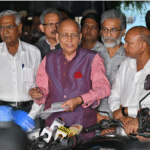Fog Blankets Delhi a thick blanket of fog descended on Delhi and surrounding areas early Monday morning, significantly disrupting train schedules and slowing life in the national capital to a crawl. As winter sets in, Delhiites woke to visibility levels dropping to alarming lows, complicating transport operations and creating hazardous conditions on the roads and railways. With nearly 75 trains delayed, several others rescheduled, and some canceled entirely, the fog’s impact is being felt across the transportation network, Fog Blankets Delhi straining commuters and highlighting ongoing environmental and infrastructural challenges.
The annual phenomenon of dense fog in northern India, Fog Blankets Delhi which worsens in the peak winter months of December and January, is exacerbated by the region’s escalating pollution levels. This year’s fog conditions come amid heightened concerns over air quality, urban infrastructure preparedness, and the broader effects of climate change. As railways, roads, and air traffic adjust to the challenges posed by the smog, Delhi’s residents are learning to navigate yet another grim chapter in the capital’s battle with winter pollution.
This article explores the disruptions caused by the dense fog, the underlying causes behind the phenomenon, and the steps needed to improve urban resilience and preparedness.
Train Schedules Affected as Visibility Drops
One of the most immediate and severe consequences of the thick fog has been its effect on rail transportation. With visibility dropping to 50 meters in some parts of Delhi-NCR, train operations across several key routes were brought to a near standstill.
Extent of Disruptions
According to Northern Railway officials, at least 75 trains have been delayed, while 13 trains were rescheduled. Additionally, reports indicate that several trains, Fog Blankets Delhi particularly those operating on long-haul routes like the Rajdhani and Shatabdi Express services, are running hours behind schedule. Passengers at Delhi’s major railway stations, including New Delhi Railway Station, Old Delhi Station, and Anand Vihar Terminal, were seen anxiously waiting as electronic boards flashed updates of delayed arrivals and departures.
Some of the key trains impacted include:
- Rajdhani Express from Mumbai to New Delhi: Delayed by 3–4 hours.
- Shatabdi Express from Amritsar: Running 2 hours behind schedule.
- Multiple trains from Eastern and Central India: Delayed due to heavy fog in regions such as Uttar Pradesh and Bihar.
The delays are impacting thousands of passengers who rely on train services for both daily commutes and long-distance travel. Long queues at ticket counters, crowded waiting areas, Fog Blankets Delhi and mounting frustration among travelers have become common scenes at railway stations across the capital.
Railway Safety Measures
With limited visibility making train operations hazardous, Indian Railways has implemented strict safety protocols to ensure commuter safety. Trains are running at reduced speeds, particularly when passing through regions engulfed in dense fog. Railway officials are also making extensive use of fog-signal devices, which provide warnings to drivers and maintain safe distances between trains. However, the safety measures, Fog Blankets Delhi while necessary, have led to extended delays and increased travel times for passengers.
Impact on Other Modes of Transport
While train delays have caused major disruptions, the fog’s effects are not limited to rail services. Delhi’s roads and air traffic are also bearing the brunt of the inclement weather, Fog Blankets Delhi compounding challenges for the city’s residents.
Road Traffic Chaos
Delhi’s roads, already plagued by congestion, faced additional challenges as the fog reduced visibility to dangerous levels. Commuters reported slow-moving traffic on major arterial roads, including the Delhi-Gurgaon Expressway, Outer Ring Road, and Noida Link Road. Highways connecting Delhi to neighboring states like Haryana and Uttar Pradesh were particularly affected, Fog Blankets Delhi with accidents reported in multiple locations.
In some areas, accidents caused by poor visibility slowed traffic further. One major collision on the Noida-Greater Noida Expressway involving multiple vehicles created significant congestion and underscored the dangers of driving in such conditions.
Traffic police and municipal agencies have deployed additional personnel and warning signs to assist drivers and reduce risks. However, poor adherence to speed limits and the absence of properly functioning fog lights in many vehicles have further complicated matters.
Flight Delays and Cancellations
Delhi’s Indira Gandhi International Airport also witnessed disruptions as fog caused visibility levels at the airport to dip below the threshold required for seamless flight operations. While Delhi Airport has advanced systems like CAT III-B ILS (Instrument Landing System), allowing limited visibility landings, Fog Blankets Delhi a number of flights were delayed and diverted due to dense fog in the early hours.
Passengers at the airport expressed frustration over last-minute flight schedule changes and long waits for updates. Airlines have issued advisories to passengers to check flight status before heading to the airport, Fog Blankets Delhi but the disruption remains a major inconvenience for travelers.  For the more information click on this link
For the more information click on this link
Why Does Delhi Experience Dense Fog?
The annual phenomenon of dense fog in northern India, particularly Delhi, is driven by a combination of meteorological, environmental, and geographical factors. While some degree of winter fog is natural, Fog Blankets Delhi experts warn that the region’s worsening pollution levels are intensifying the severity and duration of the fog each year.
Key Factors Contributing to Fog in Delhi
- Temperature Inversions:
In winter, the ground cools rapidly at night while warmer air traps cooler air closer to the surface. This phenomenon, known as a temperature inversion, limits the vertical mixing of air, Fog Blankets Delhi trapping moisture and pollutants near the surface. The result is the formation of thick fog layers. - High Pollution Levels:
Delhi’s air quality takes a massive hit during the winter months due to emissions from vehicles, Fog Blankets Delhi industries, and construction, as well as crop stubble burning in neighboring states. The high levels of particulate matter in the air provide nucleation points around which water vapor condenses, increasing the density of fog. - Geography and Climate:
Delhi’s location near the Himalayan foothills and its proximity to agricultural regions make it especially susceptible to fog. The Indo-Gangetic Plain traps pollution and fog due to limited air circulation, creating conditions ripe for dense smog.
Health and Environmental Concerns
The dense fog not only disrupts transportation but also poses significant health risks to residents, particularly vulnerable populations such as children, the elderly, Fog Blankets Delhi and those with pre-existing respiratory conditions.
Health Risks
With visibility low and particulate matter levels high, smoggy conditions are exacerbating respiratory problems, including asthma, bronchitis, and COPD. Hospitals in the NCR region are seeing an increase in patients complaining of difficulty breathing and related ailments. Additionally, Fog Blankets Delhi prolonged exposure to air pollutants during such conditions can weaken immune systems and increase long-term risks of cardiovascular and pulmonary diseases.
Doctors and health experts have advised Delhi residents to limit outdoor activity, Fog Blankets Delhi especially during peak smog hours, and to wear N95 masks when venturing out. Air purifiers for indoor spaces are also being recommended to help mitigate health risks.
Government Response and Preparedness
Measures Taken to Address Fog and Smog
The Delhi government, in coordination with the Centre, has initiated multiple measures to mitigate the effects of smog and dense fog:
- Anti-Pollution Campaigns:
Initiatives such as “Red Light On, Gaadi Off” and restrictions on construction and demolition activity aim to reduce emissions during winter months. - Fog-Specific Solutions:
Indian Railways has increased its use of anti-fog devices, improved lighting at crossings, Fog Blankets Delhi and instructed train operators to exercise extreme caution. Traffic police have also stepped up patrolling on highways to enforce speed restrictions during foggy conditions. - Emergency Preparedness:
The Delhi government has issued advisories for schools and businesses to stagger opening hours to reduce the burden on transportation systems during peak fog hours.
Despite these measures, critics argue that long-term solutions to address pollution levels, Fog Blankets Delhi including stricter vehicular emissions standards and phasing out polluting industrial practices, are not being implemented quickly enough.
Solutions to Prevent Future Disruptions
To reduce the annual disruption caused by winter fog and smog in Delhi, authorities and policymakers need to adopt a multi-pronged approach. Some possible solutions include:  For the more information click on this link
For the more information click on this link
- Improved Forecasting Systems:
Advanced fog prediction technologies, including satellite monitoring, could help railways, Fog Blankets Delhi aviation, and road traffic authorities prepare more effectively. - Expanding Public Transport:
Investments in public transport infrastructure, such as metro and electric bus services, Fog Blankets Delhi could significantly reduce vehicular emissions that exacerbate pollution and fog formation. - Cleaner Energy Initiatives:
Promoting renewable energy sources, enforcing clean vehicle policies, Fog Blankets Delhi and supporting industries in switching to greener technologies would reduce emissions in the long term. - Regional Cooperation:
Given the role of agricultural stubble burning in neighboring states, Fog Blankets Delhi collaborative efforts between Delhi, Haryana, Punjab, Fog Blankets Delhi and Uttar Pradesh are essential to tackle this transboundary issue.
Conclusion: Lessons from the Current Crisis
As dense fog blankets Delhi, the resulting disruptions to train schedules and other transport networks serve as a stark reminder of the challenges posed by urban growth, pollution, Fog Blankets Delhi and climate change. For commuters and residents, the annual winter fog season is both a logistical headache and a growing health hazard.
The delays, accidents, and inconvenience caused by the fog are not insurmountable. With coordinated efforts across governance, infrastructure development, Fog Blankets Delhi and environmental policy, the effects of fog can be mitigated and even prevented in the future. As Varanasi-bound trains stand idly on Delhi’s fog-covered tracks, they underline the urgent need for action—not just to manage immediate crises, but to build a cleaner, safer, and more resilient future for the region. ALSO READ:- V. Narayanan Assumes Charge as New ISRO Chief, Succeeding S. Somanath 2025





